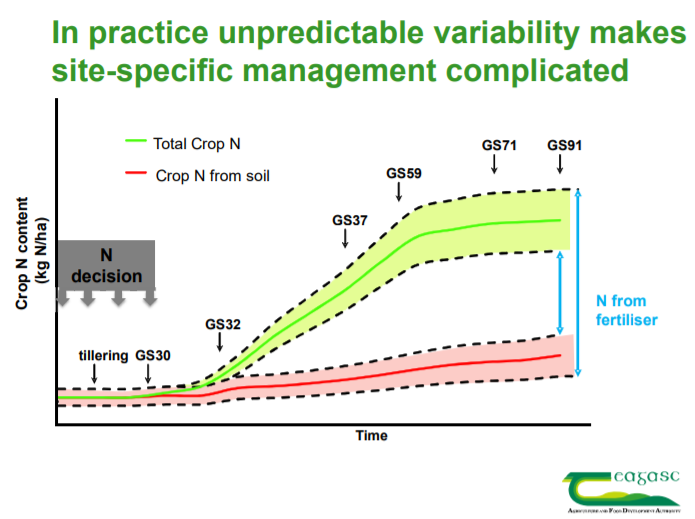“Different soils provide different amounts of nitrogen (N). The other difference that’s not being taken into account is seasonal differences – the background nitrogen in the soil. The current soil nitrogen index system is, at best, a relatively crude system.”
This was the message from Teagasc’s Richie Hackett, who spoke at the National Tillage Conference in Co. Kilkenny last week.
“We know there are differences in seasons. This is often related to over-winter rainfall levels,” he explained.
He also outlined that another problem with the system is that there is no account taken of the actual crop growth.
People decide on the recommendation before the crop goes into the ground. It doesn’t matter if it’s a good or a bad crop.
Can we do better?
Hackett went on to describe site specific management. This means applying nitrogen rates specific to an individual farm; an individual field; or within different areas of a field.
“There’s a lot of potential there to vary our nitrogen based on individual site characteristics,” he explained.
“Site specific management is all about tailoring nitrogen recommendations to a smaller area, than what is currently done, to try and get as close to the optimum level on each site as we possibly can.
The ultimate aim is to increase your yield and reduce your fertiliser impact on the environment.
“If you’re growing a crop like milling wheat or malting barley, the aim is to optimise your protein level.”
He added: “If we knew how much nitrogen was going to be in the crop at harvest and how much was going to come from the soil, then we could start to work out our nitrogen fertiliser accurately.
“Not all the fertiliser we apply goes into the crop. Typically about 60-70% of the nitrogen goes into the crop.”
Improving our estimate of soil nitrogen supply
Research has shown that soil mineral N measurements to a depth of 90cm can be beneficial in estimating soil nitrogen supply. However, this is hard work; can be expensive; and is not practical at farm level.
Hackett suggested measuring soil mineral N – in a number of fields – in the same locations every year, in order to account for seasonal variation.
“What could be done is to have a network of fields around the country that could be monitored every year for changes between one season and the next.
This would take some of the seasonal variation into account. Winter rainfall could be taken into account, but it would take a lot of calibration to get that system up and running.
Hackett stated that soil N tests, which are widely used in other countries, have not been shown to be suited to Irish conditions.
N-sensors and data from satellites have also been shown to help when deciding on fertiliser recommendations. Hackett was not suggesting that farmers go out and buy N-sensors immediately, as this equipment can be expensive.
However, he outlined that information is freely available from satellite systems to measure the crop nitrogen status. He also outlined that this could help, if it could be proved that it works.
Furthermore, work is continuing on examining these methods. However, it is expected to take some time to investigate.

